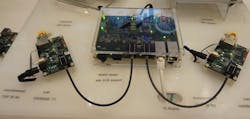Automotive Ethernet Was the Hidden Trend at CES 2016
There were a lot of trends emerging at the 2016 Consumer Electronics Show, like self-driving and electric vehicles. Chevy’s 2017 Bolt (Fig. 1) was one of the hot items at the show. It is designed to go over 200 miles between charges. The $33,170 MSRP will be even lower after the federal rebate. The Bolt is a great car that is also roomy. It does 0 to 60 mph in 7 seconds.
Toyota was showing off artificial intelligence (AI) demos using robotic models that distributed machine learning information among the group of tiny cars. They have promised to invest $1 billion in Toyota Research Institutes to investigate AI for making cars safer and more intelligent.
The one trend most silicon vendors were talking about when it came to automotive is the use of Ethernet under the hood. This is in the form of 100 Mbit/s BroadR-Reach, 100 Mbit/s 802.3bw 100Base-T1, and 1 Gbit/s, 802.3bp 1000Base-T1. All utilize a single twisted pair allowing the use of low-cost connectors and significantly lowering cabling costs. The systems provide full duplex operation and it is possible to provide power over the same twisted pair using the P802.3bu 1-Pair Power over Data Lines (PoDL) standard.
The OPEN Alliance (One-Pair Ether-Net) Special Interest Group (SIG) supports BroadR-Reach technology was developed by Broadcom. BMW is already using the technology to connect the four cameras for surround-view in the BMW X5. IEEE 802.3bw uses the same PHYs as OPEN. The faster 1000Base-T1 can handle multiple 4K video streams (Fig. 2). The standards utilize the normal Ethernet MAC, but change the PHYs.
MOST is a multimedia system currently in use on high-end automobiles, but it is ring-based versus the switched-based Ethernet. In theory, this allows Ethernet to provide more expansion that is limited by the switch throughput.
The new Ethernet standards are designed for fast startup, but limit the run length to 15 m. This is more than sufficient to handle most transportation-related applications. It is even applicable to larger platforms where switches could be connected using conventional Ethernet cabling that can handle longer connections.
The new standards target automotive applications, but they will be very useful in a range of embedded applications as well. Robotics is one that comes to mind. Ethernet is already in common use and robots would benefit from lower costs and simplified cabling.
About the Author
William Wong Blog
Senior Content Director
Bill's latest articles are listed on this author page, William G. Wong.
Bill Wong covers Digital, Embedded, Systems and Software topics at Electronic Design. He writes a number of columns, including Lab Bench and alt.embedded, plus Bill's Workbench hands-on column. Bill is a Georgia Tech alumni with a B.S in Electrical Engineering and a master's degree in computer science for Rutgers, The State University of New Jersey.
He has written a dozen books and was the first Director of PC Labs at PC Magazine. He has worked in the computer and publication industry for almost 40 years and has been with Electronic Design since 2000. He helps run the Mercer Science and Engineering Fair in Mercer County, NJ.
- Check out more articles by Bill Wong on Electronic Design
- Bill Wong on Facebook
- @AltEmbedded on Twitter


